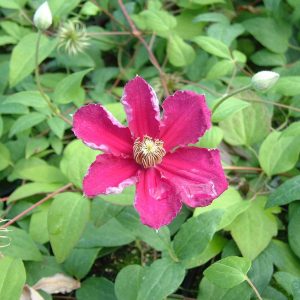Description
Rosa ‘Kew Gardens’ is a beautiful David Austin rose with small, single flowers arranged in large heads, similar to hydrangeas. These lovely blooms appear almost continuously from early summer until autumn. The soft apricot buds gradually open to reveal pure white petals with a subtle hint of soft lemon behind the stamens. In addition to its stunning blooms, ‘Kew Gardens’ is also highly regarded for its exceptional health and nearly thornless stems. This bushy, upright rose is a relatively new introduction, having been bred by David Austin in 2009. It makes a beautiful addition to any garden, adding a touch of elegance and beauty with its delicate, fragrant blooms.
Key Facts
- Common Name(s):Kew Gardens Rose
- Hardiness:Fully hardy
- How big will I get? Rosa ‘Kew Gardens’ can grow to a height of 1.2m and a spread of 1.2m.
- Did You Know That:There are over 100 different species of roses, and thousands of hybrids?
Plant Calendar
A rough guide to how this plant will change through the year.
| Jan | Feb | Mar | Apr | May | June | July | Aug | Sept | Oct | Nov | Dec | |
| Flowering Time | 
| 
| 
| 
| ||||||||
| Foliage Colour |  |
 |
 |
 |
 |
 |
 |
 |
 |
| J | F | M | A | M | J | J | A | S | O | N | D |

| 
| 
| 
| ||||||||
 |
 |
 |
 |
 |
 |
 |
 |
 |
Care Guide

Soil Requirements
Rosa ‘Kew Gardens’ prefers moist but well-draining soil. This plant can grow in soil with a wide range of pH levels, it is not picky about the pH level of the soil.

Best Position
Rosa ‘Kew Gardens’ can handle either an exposed or a sheltered position and requires full sun to thrive, this consists of more than six hours of direct sunshine per day.

Maintenance
Rosa ‘Kew Gardens’ should be pruned in late winter or early spring, before new growth begins. Begin by removing any dead, damaged, or diseased wood from the plant, making sure to sterilize your pruning shears between cuts to prevent the spread of disease. Next, cut back any old wood to encourage the growth of new shoots, cutting back to a healthy bud or lateral branch. Remove any weak or spindly growth that won’t produce good blooms, focusing on leaving strong, healthy shoots that will produce plenty of flowers. Finally, shape the plant by cutting back any overly long or unruly shoots, creating a more compact, attractive plant. By following these steps, you can keep your shrub roses healthy and blooming beautifully year after year.

Pest, Diseases and Wildlife
Rosa ‘Kew Gardens’ can have problems with aphids, leafhoppers, and scale insects , it can be vulnerable to certain diseases such as black spot, rust and powdery mildews. It is also known to attract bees, butterflies and other pollinators. It is not considered to be toxic.





